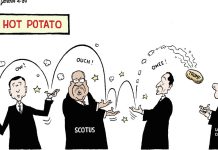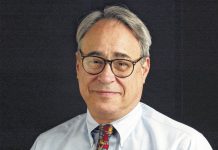My mother never met a Black person she didn’t like.
Of course, growing up in rural Southern Indiana she only came into contact with African Americans a few times — and those contacts were pretty much at a distance.
My father worked at Arvin Industries in Columbus in the 1940s and early 1950s. Each summer the company rented Riverside Amusement Park in Indianapolis for an employee family day of rides and cotton candy. Although Riverside was off limits for African Americans — (“colored people” as they were called at the ticket booth) — the park was in the middle of a Black neighborhood.
So we rode to the park from Hope several summer Saturdays, locked inside our blue Plymouth sedan, peering curiously and apprehensively out the closed windows as if we were on a photo safari in an African wild game park.
Of course, at home we weren’t totally out of personal contact with Black people. Our house was just a few blocks from the lone Black family living in Hope.
My sisters and I went to school with children from that family. And while we never went to their house to play and they never came to ours, Mom was careful to always tell us to be nice to them and that “they are just as good as you are.”
I was never sure how mom came to that conclusion, since she never had had a personal relationship, or even more than a few moments of conversation, with anyone except white people. Her lack of contact was not a decision she had made so much as a fact of the rural, white ghetto she was a part of.
By the early 1960s, however, Mom was coming into contact with African Americans more and more frequently — well, sort of.
The Civil Rights era, with all its conflict and social unrest, coupled with the magic of television, was bringing African Americans into her living room. But these were not the “smiling, happy Negroes” she had met on both TV and movie screens — the joyful slaves from “Gone With the Wind” and the bug-eyed comedians on “Amos and Andy.” These were the angry faces of Black people demanding equality and the end of segregation.
These “other Black people” were disturbing and frightening.
Their cause might be right, but my Lord, they were refusing to obey the white police officers. They were different from the few Black people she knew — the ones “just as good” as members of her own family.
In 1970, Mom moved to Bloomington to take on a job she would hold for 10 years as housemother of the Exchange Home for children in treatment at the Indiana University Department of Speech and Hearing. For the first time in her life she was living in a multi-racial, multi-cultural world.
Her supervisor was Dr. Gladys DeVane, a professor who was Black.
Some of the student clinicians who worked with the children in the program were Black. The professor became a friend and a highly admired confident.
Mom also got to know Black family members and the Black friends of her clinicians and children.
One of her clinicians was the then-girlfriend of Isaiah Thomas, an IU basketball player who would someday be an NBA star. Isaiah visited the Exchange Home occasionally and often talked and joked with her.
For the first time in her life, assumptions she had made “from a distance” about African Americans were challenged by her love and respect for Black friends and associates she actually knew.
Even at that, Mom would occasionally slip back into some vault of racial condemnation. At times she would say something racist enough to make me shudder — attaching the reason for some horrible act she saw on TV to race.
I would ask her what she meant by “they” (meaning all Blacks, I suppose) when criticizing an individual who had committed a crime.
“What about Dr. DeVane? What about Isaiah?” I would ask her. “Are they the ‘they’ you are talking about.”
“Of course not,” she would respond. “They are different.”
Mom was a good and loving woman, but a woman struggling to shed the knee-jerk reactions left from the insulated times and isolated places of her life.
Mom indeed never met a Black person she didn’t like; but she struggled to believe those she met were not an exception to the general rule.
Sad.
Too many of us — however we identify ourselves racially, ethnically, sexually, socially, geographically — spend too much of our lives riding in that blue Plymouth with locked doors and sealed windows, on our way to a segregated amusement park.
Bud Herron is a retired editor and newspaper publisher who lives in Columbus. He served as publisher of The Republic from 1998 to 2007. Contact him at [email protected].





